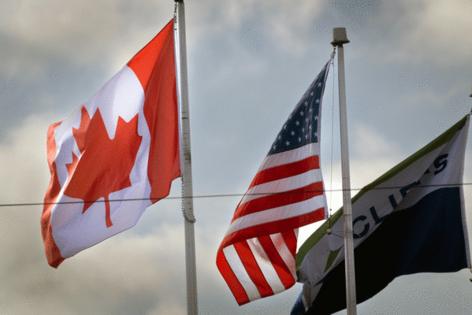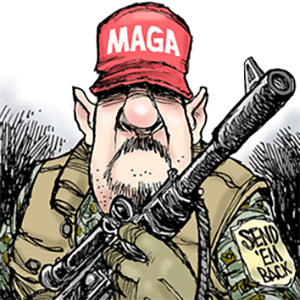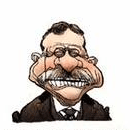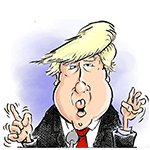Trump escalates Canada trade fight with 35% tariff threat
Published in News & Features
President Donald Trump threatened a 35% tariff on some Canadian goods and raised the prospect of increasing levies on most other countries, ramping up his trade rhetoric in comments that weighed on stocks and boosted the U.S. dollar.
The tariff level on Canada would take effect from Aug. 1, the president said. The announced rate is an increase from the current 25% tariff that’s imposed on U.S. imports from Canada that aren’t shipped under the terms of the U.S.-Mexico-Canada Agreement.
“Fentanyl is hardly the only challenge we have with Canada, which has many Tariff, Non-Tariff, Policies and Trade Barriers, which cause unsustainable Trade Deficits against the United States,” Trump said in a letter to Canadian Prime Minister Mark Carney, posted on social media Thursday.
Trump’s announcement on Canada came as he told NBC News on Thursday that he’s also eyeing blanket tariffs of 15% to 20% on most trading partners. The current global baseline minimum tariff rate for nearly all U.S. trading partners is 10%.
“We’re just going to say all of the remaining countries are going to pay, whether it’s 20% or 15%. We’ll work that out now,” NBC quoted Trump as saying. “I think the tariffs have been very well-received. The stock market hit a new high today,” Trump added, according to the report.
Taken together, the moves signal Trump is not abandoning his flagship economic policy. U.S. equities were poised to retreat from a record high, with contracts for the S&P 500 dropping 0.6%. The Bloomberg Dollar Spot Index rose 0.1%. Treasury yields advanced across the curve.
In response to Trump, Carney said that Canada would continue to defend workers and businesses as it continues negotiating with the U.S. ahead of the Aug. 1 deadline. He added in the post on X that Canada has made “vital progress” in combating fentanyl in North America and is committed to working with the U.S. on the issue.
The 35% Canada levy mentioned by Trump currently doesn’t apply to goods that are traded within the rules of USMCA — and the exclusion is poised to remain in place, according to an official who requested anonymity to discuss the matter.
The U.S. is also expected to keep a lower 10% tariff on some energy-related imports, the official said. The move would not affect higher levies on key materials such as steel and aluminum, which are under a different tariff regime. The situation remains fluid and the legal order has not yet been drafted, they cautioned. Trump’s tariff plans are unpredictable and often revised, including immediately prior to a deadline.
As it currently stands, the formula would be a far more modest change to the trading relationship than an across-the-board 35% rate. Most of Canada’s exports to the U.S. fall under the rules of USMCA.
It would preserve exceptions in closely integrated sectors like the auto industry, where the flow of trade between the two countries is fairly balanced. Canada is by far the largest foreign market for U.S. vehicles, importing about 629,000 American-made cars and light trucks last year, according to U.S. government data.
Still, the letter suggests Trump is intent on ratcheting up rather than scaling back his trade war with the U.S.’s northern neighbor — which he has mused publicly should consider becoming the 51st state — despite furious efforts by Canadian officials to broker a deal.
“It’s indicative of how volatile these negotiations are,” said Flavio Volpe, head of the Automotive Parts Manufacturers’ Association, a Canadian industry group.
The president has spent the week sending missives to trading partners, informing them of new rates that will kick in on Aug. 1 if they cannot negotiate better terms. Letters to members of the European Union are also expected shortly.
The Canada letter is “a big shock, still meaningful for the Canadian economy, and the cadence at which he’s issuing these letters and threatening to put universal tariffs on other countries is very, very negative for financial markets more generally,” said Karl Schamotta, chief market strategist at Corpay.
“It does look as if negotiations between Trump and Canada and many other countries have essentially been irrelevant to the process. And so, unfortunately, the interpersonal relationship that many leaders have invested in building with Mr. Trump, that effort has largely been wasted,” he said.
Trump’s Canada announcement came after officials in Ottawa denounced U.S. plans to impose a 50% import tariff on copper.Canada is one of the largest suppliers of the metal to the U.S.
“We are waiting for the details of this decision by the White House and by the president, but we’ll fight against it, period,” Canada Industry Minister Melanie Joly said earlier Thursday, referring to the copper tariffs.
The talks between the U.S. and Canada had already shown signs of stress. Last month, Trump briefly cut off negotiations after Canada moved to implement a digital services tax, only for the Canadian government to drop the initiative.
‘Leverage our options’
While a majority of Canadian exports to the U.S. are shielded from Trump’s tariffs, thanks to the USMCA trade agreement, the president had signed an executive order imposing a 25% tariff on many goods, citing the threat of fentanyl. Products qualify for the USMCA exemption if they comply with the rules of that agreement.
The trade deal, for example, sets out a complex set of “rules of origin” for automotive components. Only cars and trucks that meet a minimum level of North American content are considered USMCA-compliant.
Metals, including steel and aluminum, are currently subject to a 50% tariff.
“It further resolves Canadian efforts to find new trading partners,” Heather Exner-Pirot, senior fellow at the Macdonald-Laurier Institute in Ottawa. “We have a surplus of food, energy and critical minerals. We’re a reliable trading partner that doesn’t bring strings attached. We need to leverage our options.”
Data from the U.S. government suggests that very little fentanyl, a highly addictive drug, is trafficked across the U.S.-Canadian border.
Trump did allow that he would “consider an adjustment to this letter” if Canada worked with him to stop the flow of fentanyl. But he criticized Canadian authorities for their existing tariffs on U.S. dairy products and said the government had “financially retaliated against the United States.”
---------
—With assistance from Andy Lin, John Harney, Randy Thanthong-Knight, Romy Varghese, Melissa Shin, Thomas Seal, Matthew Burgess and Derek Decloet.
©2025 Bloomberg L.P. Visit bloomberg.com. Distributed by Tribune Content Agency, LLC.







Comments